|
|
July 21st, 2013
Story based on Report by Ashley Brugnone, CMP Writer
It takes lots of labor to make the National Matches at Camp Perry run smoothly. Many hard-working young people are involved each summer with the range crew and the target crew. Range crew personnel assemble (and later remove) range facilities used for the events. Target crew members collectively paste 250+ High Power targets a day and 80,000 pistol targets a season. The crew members’ countless hours on the Camp Perry ranges don’t go unnoticed. The National Match partners, the National Rifle Association (NRA), the Ohio National Guard, and the Civilian Marksmanship Program (CMP) are grateful to have hard-working, dedicated young people working the Camp Perry ranges.

“The Matches would not exist without these kids,” said Tommy Whitten, CMP logistics department manager. Whitten has been with the CMP since 1994.
 Joe DeCosta, now 81 years old, has run the National Match Summer Crew program for 30 years. Generally, each summer Joe hires about 60 boys and girls around the ages of 14 or 15, who have the potential to return for years to come, which, more often than not, they do. Joe DeCosta, now 81 years old, has run the National Match Summer Crew program for 30 years. Generally, each summer Joe hires about 60 boys and girls around the ages of 14 or 15, who have the potential to return for years to come, which, more often than not, they do.
“I don’t just want a worker. I want a young man or woman to be proud to be here, to be building this range for the National Championship,” he said. “Loyalty is very important, and these kids have been very loyal to me over the years.”
One of his loyal employees is Steve Young, 20, of Oak Harbor, who has been working at Camp Perry for the past six years. Steve enjoys the job: “You can start at a really young age, and make a pretty good amount of money. I like being able to sit back and watch the Matches. It’s fun with the guys out here too.”
Ralph Reichman, assistant range engineer, observes: “We get a different set of 4, 5, 6 kids from one family. Once one leaves, then the youngest one comes through. We’re like a big family.”

Brian Wyss, 18, of Oak Harbor, has been helping CMP for the last three summers. After shooting at the CMP Marksmanship Center, he wanted to become a part of the process: “I shot a lot of air rifle, so I know most of the people, and it’s fun getting to meet other people from around the world”.

July 21st, 2013
 In 2003, the venerable Colt business enterprise, was divided into different entities, Colt Defense LLC and Colt’s Manufacturing Company LLC. Now those two business are being combined back into one company again. Colt Defense LLC has acquired New Colt Holding Corp., the parent company of Colt’s Manufacturing Company LLC, which makes firearms for the civilian and sporting markets. Now, for the first time since the separation a decade ago, a single Colt company will develop, manufacture and sell firearms under the Colt name for all markets. In 2003, the venerable Colt business enterprise, was divided into different entities, Colt Defense LLC and Colt’s Manufacturing Company LLC. Now those two business are being combined back into one company again. Colt Defense LLC has acquired New Colt Holding Corp., the parent company of Colt’s Manufacturing Company LLC, which makes firearms for the civilian and sporting markets. Now, for the first time since the separation a decade ago, a single Colt company will develop, manufacture and sell firearms under the Colt name for all markets.
About Colt: Colt is one of the world’s leading designers, developers and manufacturers of firearms. The company has supplied military, law enforcement and individual customers in the United States and throughout the world for more than 175 years. Colt’s subsidiary, Colt Canada Corporation, is the Canadian government’s source for small arms and is the Canadian military’s sole supplier of the C7 rifle and C8 carbine. Colt operates its manufacturing facilities in West Hartford, Connecticut and Kitchener, Ontario. For more information on Colt and its subsidiaries, please visit www.colt.com, www.coltsmfg.com, and www.coltcanada.com.
Story Tip by EdLongrange. We welcome reader Submissions.
July 20th, 2013
We thought the USA enjoyed the coolest shooting stuff. But the Brits may have one-upped us this time. Now available in the United Kingdom (but not the USA) are Firebird exploding, reactive targets. These affordable, pyrotecnic targets are offered in four different models: Hi-velocity rifle (rimfire and centerfire), Air Rifle, Shotgun, and Archery. Unlike the binary explosive kits available in the USA, Firebird targets are ready-to go right out of the box. You just take the adhesive-backed target disc out of the box, and place it on the target frame. (The air rifle version requires a small retaining cup behind the target disc.) For the shotgun Firebird targets, you simply stick the Firebird disc on the back of a clay pigeon. Peel and stick — simple as that.

Here’s a video showing Firebird targets in use. (See more videos on the Firebird website). Looks like good fun to us — the targets go bang with a puff of smoke when hit. Simple to use. No messy chemicals. No mixing required. Just stick ‘em on the target backer and shoot. Kudos to the Brits for bringing this to market in the UK. Hopefully we will see Firebird targets on this side of the Atlantic sometime soon.
 Sniperfire Exploding Targets Sniperfire Exploding Targets
The Firebird SniperFire 40mm and 65mm are designed specifically for use with any high velocity firearm, rimfire or centerfire. Backed with double-sided tape, SniperFire targets can be affixed to any clean, dray and uniform surface such as plywood, fluted plastic, or stiff cardboard. Now being used by military and police units in many countries, the Firebird SniperFire is a practical training tool that gives shooters “instant gratification” when hitting the target. SniperFire targets cost £18.95 ($28.92) for twenty 40mm discs, or £19.95 ($30.45) for twenty 65mm discs.
 Airflash Standard Air Rifle Exploding Targets Airflash Standard Air Rifle Exploding Targets
Specifically designed for use with air rifles, Firebird Airflash Targets come in 40mm or 65mm sizes. Once hit with an air rifle pellet, the target ignites with “a significant pyrotechnic reaction and loud report” as the Brits say. In other words, it goes “bang” with big cloud of smoke. The £24.95 Airflash Starter Kit includes twenty 40mm reactive targets and an Airflash Magplate (sort of like a small-cupholder). Airflash 40mm refills (with 20 targets) cost £18.45. The 65mm refills are £19.95.

July 20th, 2013
 Bushnell Outdoor Products has introduced a new compact, roof prism spotting scope. The new Bushnell Elite Tactical 8-40x60mm Lightweight Modular Spotting Scope (LMSS) features a rubber-armored housing, ED Glass, and an optional (extra cost) H32 ranging reticle. A Picatinny rail is supplied that fits to the bottom of the LMSS. Bushnell Outdoor Products has introduced a new compact, roof prism spotting scope. The new Bushnell Elite Tactical 8-40x60mm Lightweight Modular Spotting Scope (LMSS) features a rubber-armored housing, ED Glass, and an optional (extra cost) H32 ranging reticle. A Picatinny rail is supplied that fits to the bottom of the LMSS.
The Elite Tactical 8-40x 60mm LMSS features ED Prime glass, BAK-4 prisms and fully multi-coated optics. The LMSS is available in both a standard (clear view) model or with the Horus Vision H32 reticle, a highly-regarded ranging reticle. With a minimum 8X magnification, and a maximum of 40 power, the LMSS is extremely versatile.
Sheathed in rubber armor, the LMSS spotting scope is fog-proof and meets IPX7 waterproof standards. It also features the water-repellant RainGuard HD lens coating, a patented Bushnell technology that we have found works very well.
The spotting scope includes a detachable picatinny rail, giving users the ability to quickly and easily mount the spotter to a firearm or tripod system. The Elite Tactical 8-40x 60mm LMSS is available for an estimated retail price of $1699.99 or $2,199.99 with the Horus H32 reticle.
Bushnell Bulletproof 100% Money-Back Guarantee
Every product in the Elite Tactical series is covered by the Bushnell limited lifetime warranty. The entire product line is also backed with the new one-year, no-risk Bushnell Bulletproof Guarantee. The 100% money-back guarantee is valid up until one year from date of purchase.
July 20th, 2013
 Would you like to help lead the fight for gun rights in the Golden State? Then read on. The California Rifle and Pistol Association (CRPA) is now seeking a full-time Field Rep with a salary of $45,000 per year. With 42,000 members statewide, the CRPA is the largest and oldest pro-Second Amendment/Pro-Hunting organization headquartered in California. Would you like to help lead the fight for gun rights in the Golden State? Then read on. The California Rifle and Pistol Association (CRPA) is now seeking a full-time Field Rep with a salary of $45,000 per year. With 42,000 members statewide, the CRPA is the largest and oldest pro-Second Amendment/Pro-Hunting organization headquartered in California.
The Field Representative job is an exciting, challenging position that takes you out of the office. You’ll get paid to travel all around California spreading the “good news” about the CRPA at shooting competitions, gun shows, sporting goods stores, and ranges. The Field Rep holds a key position. You will be the primary “point man” for the CRPA at many events statewide.
CRPA Protects and Defends Second Amendment and Hunting Rights in California. Since its founding in 1875, the CRPA has been the guiding force in the development and coordination of statewide shooting championships. In addition, the CRPA serves as the official state affiliate of the National Rifle Association. The CRPA coordinates an aggressive legislative advocacy and effective litigation programs.
Position Title: Field Representative
Location: CALIFORNIA (Extensive ongoing travel, throughout the state)
Salary: $45,000 Annually, plus company vehicle, benefits, expense reimbursement, lap top computer, and cell phone.
Education – An A.A., A.S., or higher degree in public relations, communications, political science, business or public administration, criminal justice or a related field is desirable.
Position Key Characteristics: Under the general direction of the Executive Director, incumbent serves as the sole Field Rep. for the CRPA. Incumbent’s primary focus is membership development and making the CRPA name, goals, and objectives widely known by the public. Incumbent must possess a strong knowledge of shooting sports, firearms, and hunting activities. This position requires frequent ongoing travel and working days, unusual hours, evenings, and most weekends. This position will write a monthly column in our publication and provide staff support to the CRPA Volunteer Development Committee and the CRPA Hunting and Wildlife Conservation Committee. Incumbent must be mature, professional, and possess excellent communication skills both verbally and in writing.
To Apply: Call CRPA at 1-800-305-2772 or email contact@crpa.org and ask for the CRPA application packet, including supplemental questions, emailed to you. Recruitment Closing Date: THE COMPLETED CRPA APPLICATION PACKET MUST BE RECEIVED NO LATER THAN TUESDAY, August 13, 2013 – 4:00 PM (No postmarks).
NOTE: This is an “at will” position and only one year of funding for this position has been secured at this time. Future funding will be based on the contribution this position makes to the CRPA.
July 19th, 2013
Breaking News: SPC Hall Wins Camp Perry 3-P Championship
Port Clinton, Ohio – With a final score of 2383-171x, Specialist Joseph Hall of the U.S. Army Marksmanship Unit captured the 2013 NRA Smallbore 3-Position Rifle title in Camp Perry, Ohio. Besting fellow U.S. Army Marksmanship teammate Jason Parker by a total of three points, this is Hall’s first overall title at the National Championships.
The Smallbore 3-Position Championships consists of two separate phases — Metallic Sights and Any Sights. During each phase, shooters fire their smallbore rifles from the standing, kneeling, and prone positions. Out of a possible 2,400 points, Hall dropped a mere 17 points.
Story based on report by Lars Dalseide for NRABlog
The first match this Friday (19 July) at the NRA National Smallbore 3-Position Championships in Camp Perry was one for the history books. The first match, shot prone with “any sights”, ended in three-way perfection. For not only were three shooters tied for first, they were tied with a perfect score of 400-40X (“X” is a bullseye).

“Not something you see every year,” said Match Director H.Q. Moody. “Not something you see for a lot of years.” Perfect scores meant there was a chance to chase the National Record. All you have to do is keep hitting bulls until you miss. Nothing like carving your name into a little bit of NRA history, aye? For one of these three shooters — Reya Kempley, Joseph Hall (of the USAMU), and Michael McPhail — immortality was in reach.
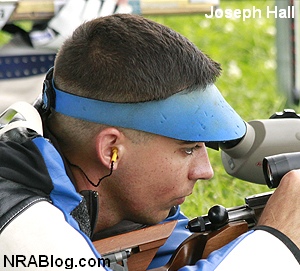 But the weather gods intervened. As Kempley, Hall and McPhail got ready for the the shoot-off — lightning struck, quite literally. As lightning flashed and thunder roared, the shoot-off was delayed. With officials calling for a fifteen minute break, rangemasters, spectators and staff scattered for shelter. When the match resumed (Kempley barely made it to the line in time), the three competitors went at it. All three had early misses (nines instead of tens), so there would be no new record. Kemply was off her game, finishing third, but the two men finished with identical 199-19X scores — just one shot off perfect. But the weather gods intervened. As Kempley, Hall and McPhail got ready for the the shoot-off — lightning struck, quite literally. As lightning flashed and thunder roared, the shoot-off was delayed. With officials calling for a fifteen minute break, rangemasters, spectators and staff scattered for shelter. When the match resumed (Kempley barely made it to the line in time), the three competitors went at it. All three had early misses (nines instead of tens), so there would be no new record. Kemply was off her game, finishing third, but the two men finished with identical 199-19X scores — just one shot off perfect.
Hall was awarded the match by application of an NRA tie-breaker rule — on the basis that Hall’s one “miss” (i.e. not scoring a bullseye 10X) occurred earlier in the shoot-off’s record string than did the single “miss” by McPhail. The thinking behind this rule is that it is more difficult to shoot consecutive 10Xs later in the match.
July 19th, 2013

At its scenic Bloomfield, New York facility, Crosman hosted the largest regional competition sanctioned by the American Field Target Association (AFTA) and the 2013 edition of the Northeast Regional Field Target Championship (NRFTC). Over one hundred competitors (and three international teams) participated in the two-day rifle match, single day pistol match, and Quigley Bucket Challenge.

The big draw was Team USA as they prepare to attend the World Field Target Federation Championship in Germany in August. Nine members of the 15-member team were on hand including past NRFTC champions Hector Medina, Greg Sauve and Harold Rushton. They were joined by five shooters of Team Venezuela and when a few Canadian participants formed Team Canada, the international side match was on. Scores were based on the team aggregate and after Day 1 it was Team USA (41.33) leading Team Canada (38.83) and Team Venezuela (36.80). Anchored by Rushton, Sauve, and Ray Apelles, Team USA took the weekend with an aggregate score of 88.66. Team Canada finished with 78.66, and Team Venezuela posted a 72.60.
CLICK HERE for complete Team and Individual Match Results.

Quigley Bucket Challenge
Always a favorite pre-event competition, the Quigley Bucket Challenge is a re-creation of the dramatic scene in the film Quigley Down Under in which Tom Selleck’s character must shoot a bucket at 700 yards. Scaled for airguns, this equates to a 1.75″ target placed at 55 yards. Shooters must use a 6.5 ft-lb. rifle using only open / iron / non-magnified sights. The Quigley had 45 shooters try five shots apiece. Just eight hit the bucket and after two over-times, Greg Sauve was the only shooter to repeat the feat, thereby winning the Challenge.


Tech Talk: Why the Big Side-Wheels on the Scopes?
Field Target rifles shoot pellets propelled by compressed air. These light-weight, low-BC projectiles drop very quickly, with a looping trajectory. In order to hit targets at distances out to 50 yards or so, you have to adjust your scope to compensate for pellet drop. But you can’t set the scope correctly without knowing the precise range to the target. This is the function of the big wheels on the side of the scope. Field Target Competitors use the parallax adjustment on high-magnification scopes to determine target range. The big wheel allows quick, yet precise parallax adjustment. Markings on the wheel show the shooter the scope settings required for the distance “dialed-in” via the over-size parallax wheel.

See More Photos at Crosman Flickr.com Photo Archive
Photos courtesy Crosman Corp., All Rights Reserved
July 18th, 2013
In our Shooters’ Forum, one member posed the question: “What makes an AR accurate? What parts on an AR can really affect accuracy — such as free-floating handguards, barrels, bolts, bolt carriers?” He wanted an honest, well-informed answer, not just sales pitches. Robert Whitley posted a very comprehensive answer to this question, based on his experience building and testing dozens of AR-platform rifles. Robert runs AR-X Enterprises, which produces match-grade uppers for High Power competitors, tactical shooters, and varminters.

Building an Accurate AR — What is Most Important
by Robert Whitley
There are a lot of things that can be done to an AR to enhance consistent accuracy, and I use the words “consistent accuracy” because consistency is a part of it (i.e. plenty of guns will give a couple great 5-shot groups, but won’t do a very good 10- or 20-shot groups, and some guns will shoot great one day and not so good on others).
Here are things we think are important to accuracy.
1. Great Barrel: You’ll want a premium match-grade barrel, well-machined with a good crown and a match-type chambering, true to the bore and well cut. The extension threads must also be cut true to the bore, with everything true and in proper alignment.
2. Rigid Upper: A rigid, heavy-walled upper receiver aids accuracy. The typical AR upper receiver was made for a lightweight carry rifle and they stripped all the metal they could off it to make it light to carry (which is advantageous for the military). The net result are upper receivers that are so thin you can flex them with your bare hands. These flexible uppers are “strong enough” for general use, but they are not ideal for accuracy. Accuracy improves with a more rigid upper receiver.

3. True Receiver Face: We’ve found that truing the receiver face is valuable. Some may argue this point but it is always best to keep everything related to the barrel and the bore in complete alignment with the bore (i.e. barrel extension, bolt, upper receiver, carrier, etc.).
4. Barrel Extension: You should Loctite or glue the barrel extension into the upper receiver. This holds it in place all the way front to back in the upper receiver. Otherwise if there is any play (and there typically is) it just hangs on the face of the upper receiver completely dependent on the face of the upper receiver as the sole source of support for the barrel as opposed to being made more an integral part of the upper receiver by being glued-in.
 5. Gas Block: You want a gas block that does not impose pointed stress on the barrel. Clamp-on types that grab all the way around the barrel are excellent. The blocks that are pinned on with tapered pins that wedge against the barrel or the slip on type of block with set screws that push up from underneath (or directly on the barrel) can deform the bore inside of the barrel and can wreck the accuracy of an otherwise great barrel. 5. Gas Block: You want a gas block that does not impose pointed stress on the barrel. Clamp-on types that grab all the way around the barrel are excellent. The blocks that are pinned on with tapered pins that wedge against the barrel or the slip on type of block with set screws that push up from underneath (or directly on the barrel) can deform the bore inside of the barrel and can wreck the accuracy of an otherwise great barrel.
6. Free-Float Handguard: A rigid, free-float handguard (and I emphasize the word rigid) really makes a difference. There are many types of free-float handguards and a free-float handguard is, in and of itself, a huge improvement over a non-free-float set up, but best is a rigid set-up. Some of the ones on the market are small diameter, thin and/or flexible and if you are shooting off any type of rest, bipod, front bag, etc., a rigid fore-end is best since ARs want to jump, bounce and twist when you let a shot go, as the carrier starts to begin its cycle before the bullet exits the bore.
7. Barrel Contour: You want some meat on the barrel. Between the upper receiver and the gas block don’t go real thin with a barrel (we like 1″ diameter if it’s workable weight-wise). When you touch off a round and the bullet passes the gas port, the gas system immediately starts pressuring up with a gas impulse that provides vibrations and stress on the barrel, especially between the gas block back to the receiver. A heavier barrel here dampens that. Staying a little heavier with barrel contour through the gas block area and out to the muzzle is good for the same reasons. ARs have a lot going on when you touch off a round and the gas system pressures up and the carrier starts moving (all before the bullet exits the bore) so the more things are made heavier and rigid to counteract that the better — within reason (I’m not advocating a 12-lb barrel).
8. Gas Tube Routing Clearance: You want a gas tube that runs freely through the barrel nut, through the front of the upper receiver, and through the gas key in the carrier. Ensure the gas tube is not impinged by any of them, so that it does not load the carrier in a stressed orientation. You don’t want the gas tube bound up so that when the gas tube pressures up it immediately wants to transmit more force and impulse to the barrel than would normally occur. We sometimes spend a lot of time moving the gas block with gas tube on and off new build uppers and tweaking gas tubes to get proper clearance and alignment. Most gas tubes do need a little “tweaking” to get them right — factory tubes may work OK but they typically do not function optimally without hand-fitting.
9. Gas Port Tuning: You want to avoid over-porting the gas port. Being over-gassed makes the gas system pressure up earlier and more aggressively. This causes more impulse, and increases forces and vibration affecting the top end and the barrel. Tune the gas port to give the amount of pressure needed to function properly and adequately but no more.
10. Front/Back Bolt Play: If accuracy is the game, don’t leave a lot of front/back bolt play (keep it .003″ but no more than .005″). We’ve seen factory rifles run .012″ to .015″ play, which is OK if you need to leave room for dirt and grime in a military application. However, that amount of play is not ideal for a high-accuracy AR build. A lot of front/back bolt play allows rounds to be hammered into the chamber and actually re-formed in a non-consistent way, as they are loaded into the chamber.
11. Component Quality: Use good parts from a reputable source and be wary of “gun show specials”. All parts are NOT the same. Some are good, some are not so good, and some aftermarket parts are simply bad. Don’t be afraid to use mil-spec-type carriers; by and large they are excellent for an accuracy build. Also, remember that just because a carrier says “National Match” or something else on it does not necessarily mean it’s any better. Be wary of chrome-plated parts as the chrome plating can change the parts dimensionally and can also make it hard to do hand-fitting for fit and function.

12. Upper to Lower Fit: A good upper/lower fit is helpful. For quick and dirty fit enhancement, an Accu-Wedge in the rear helps a lot. The ultimate solution is to bed the upper to a specific lower so that the upper and lower, when together, are more like one integral unit. For the upper receivers we produce, we try to get the specs as close as we can, but still fit the various lowers in the market place.
13. Muzzle Attachments: Don’t screw up the muzzle (literally). Leave as much metal on the barrel at the muzzle as you can. People like to thread the muzzle for a flash hider, suppressor, muzzle brake, or some other attachment, but if you really want accuracy, leave as much metal as you can there. And, if you have something that screws on, set it up so that it can be put on and have it stay there without putting a lot of torque and stress on it right where the bullet exits the bore. If you are going to thread the end of the barrel, make it concentric with the bore and make sure what you screw on there is as well. For all muzzle attachments, also ensure that the holes through which the bullet passes through are dead true to the bore. Many aftermarket screw-on things are not so good that way. Anything that vents gas should vent symmetrically (i.e. if it vents left, it should vent equally right, and likewise, if it vents up, it should vent down equally). Uneven venting of gas can wreck accuracy.
14. Quality Ammunition: Ammo is a whole story by itself, but loads that are too hot typically shoot poorly in an AR-15. If you want accuracy out of an AR-15, avoid overly hot loads. Shown below are test groups shot with four (4) different uppers, all with moderate loads. These four uppers all pretty much had the same features and things done to them as explained in this article, and they all shot great.

Robert Whitley
www.6mmAR.com
July 18th, 2013
 This article by Corey Swantz originally appeared in The Reloading Press, the Sinclair Int’l Blog. This article by Corey Swantz originally appeared in The Reloading Press, the Sinclair Int’l Blog.
Much less precision is required to get good scores in 3-gun competition than in strictly accuracy-oriented disciplines like F-Class or Benchrest. In 3-gun, [the game is] about hitting targets in the shortest amount of time, not how close to the center of the target you can get or how small the group can be. Ammunition that’s accurate to 1-2 MOA is more than sufficient for 3-gun competition, as the targets tend to be 4-6 MOA in size.
For my personal 3-gun load testing, I used three powders: Varget, IMR 8208 XBR, and Accurate 2230. All three powders gave me good results, but the 8208 XBR was the leader of the pack. I settled on a moderate charge that pushes a 73gr Berger BTHP at about 2,500 fps through my 16″-barreled AR15. While I’m sure I could obtain a higher velocity with these bullets, this speed yielded the best accuracy results in my initial testing with fully prepped brass.
With the high volume of ammunition that I need for 3-gun matches and practice, I wanted to eliminate as many case prep steps as possible and still end up with ammunition that was accurate enough for 3-gun. I fully prepped some once-fired brass from primer pocket to case mouth and everything in between. I also took some once-fired cases that had simply been trimmed to length, and loaded them without doing any other prep work. With these loads in hand, I headed out to the range to shoot some groups. Below are the results from my 200 yard group tests:
Prepped Brass Delivered Higher Score on Bullseye Target

As you can see from the photos, the groups yielded results along the lines of what I expected. The fully-prepped brass produced five 10s , whereas the un-prepped brass produced only two 10s, and both of those just touched the outer edge of the 10-ring.
However, the un-prepped brass kept all the shots inside the 8-ring, which is plenty precise for shooting the large targets used in 3-gun matches.
National Defense Match at Camp Perry
I decided to further test my un-prepped brass loads by shooting them in the National Defense Match (NDM) at Camp Perry and the Rockcastle 3-Gun Pro-Am Championship. At the NDM, the target used in the longer-range stages was a standard-size NRA Tombstone target, similar to the targets used in most 3-gun matches. Using the un-prepped brass loads, I was able to keep all my shots on the tombstone targets from 100-300 yards, and had only one miss from the 400-yard line. That one miss was my fault, as I jerked the trigger on the last shot, pulling it off to the left. Un-prepped brass held up quite well under Camp Perry NDM conditions.
Un-Prepped Good Enough for Class Win at Rockcastle 3-Gun Pro-Am Championship
Two weeks after the NDM, I traveled to Kentucky for the Rockcastle 3-Gun Pro-Am Championship. There were seven stages in this match, two of which required long-range rifle shots with my AR15. The longest stage of the match had eight steel targets sized from 4″ to 10″ in diameter, placed from 75 to 265 yards. My ammunition proved accurate enough at these distances to neutralize all the steel targets with single shots, something few other shooters were able to do. I finished over two seconds ahead of the nearest competitor on this stage and ended up winning the event. Clearly un-prepped brass was plenty good for the Rockcastle 3-Gun Pro Am, too!
Because of the results I’ve gotten on the practice range, and two very solid performances in competition last year, I feel confident that my loading process for the upcoming 3-Gun Nation Semi-Pro Series will consist of simply sizing and trimming brass, then loading it with my preferred recipe. While the fully prepped brass was indeed more accurate, the un-prepped brass loads were accurate enough to allow me to hit 3-gun targets . Now, I can take the time I save in the reloading room and spend it out on the practice range.
Corey Schwanz, Sinclair Reloading Technician
July 18th, 2013
Creedmoor Sports is selling a new product that may be useful for folks who haul multiple rifles to the range. The new ScopeSaver Trunk Rack is a freestanding gun rack designed to hold one to four rifles or shotguns during transport. The rack can also be used to display guns and/or hold them during cleaning operations. The product is called a “ScopeSaver” because it allows scoped rifles to be transported upside-down, which provides more clearance for the scopes.
Each firearm rests in a pair of 3″-high, felt-covered U-shaped brackets (aka scounces). One sconce of each pair holds guns with thick stocks, and the other holds stocks that are thinner. Firearms can also be placed in the rack either right-side-up or upside-down depending on their shape. Depending on their size, some guns can also be placed in the rack while inside soft cases.
 The ScopeSaver Trunk rack holds four guns, is 23.5” deep, 23 7/8” wide, 13” high and is made of 10% fiberglass-filled polypropylene. It holds two large and two small oil/cleaning solution containers and multiple cleaning rods of different sizes. A special tapered-slot binding system allows several rods to be stored. The ScopeSaver Trunk rack holds four guns, is 23.5” deep, 23 7/8” wide, 13” high and is made of 10% fiberglass-filled polypropylene. It holds two large and two small oil/cleaning solution containers and multiple cleaning rods of different sizes. A special tapered-slot binding system allows several rods to be stored.
Reinforced carrying handles are built into the rack. The four corners of the rack are flat on the bottom, so adhesive-backed Velcro strips can be attached (which should grip on carpeted trunks). Additionally, you can insert tie-downs through slots in each of the four lower corner braces.

Product tip from EdLongrange. We welcome reader submissions.
|

 Joe DeCosta, now 81 years old, has run the National Match Summer Crew program for 30 years. Generally, each summer Joe hires about 60 boys and girls around the ages of 14 or 15, who have the potential to return for years to come, which, more often than not, they do.
Joe DeCosta, now 81 years old, has run the National Match Summer Crew program for 30 years. Generally, each summer Joe hires about 60 boys and girls around the ages of 14 or 15, who have the potential to return for years to come, which, more often than not, they do.













 In 2003, the venerable Colt business enterprise, was divided into different entities, Colt Defense LLC and Colt’s Manufacturing Company LLC. Now those two business are being combined back into one company again. Colt Defense LLC has acquired New Colt Holding Corp., the parent company of Colt’s Manufacturing Company LLC, which makes firearms for the civilian and sporting markets. Now, for the first time since the separation a decade ago, a single Colt company will develop, manufacture and sell firearms under the Colt name for all markets.
In 2003, the venerable Colt business enterprise, was divided into different entities, Colt Defense LLC and Colt’s Manufacturing Company LLC. Now those two business are being combined back into one company again. Colt Defense LLC has acquired New Colt Holding Corp., the parent company of Colt’s Manufacturing Company LLC, which makes firearms for the civilian and sporting markets. Now, for the first time since the separation a decade ago, a single Colt company will develop, manufacture and sell firearms under the Colt name for all markets.
 Sniperfire Exploding Targets
Sniperfire Exploding Targets Airflash Standard Air Rifle Exploding Targets
Airflash Standard Air Rifle Exploding Targets
 Bushnell Outdoor Products has introduced a new compact, roof prism spotting scope. The new Bushnell Elite Tactical 8-40x60mm Lightweight Modular Spotting Scope (LMSS) features a rubber-armored housing, ED Glass, and an optional (extra cost) H32 ranging reticle. A Picatinny rail is supplied that fits to the bottom of the LMSS.
Bushnell Outdoor Products has introduced a new compact, roof prism spotting scope. The new Bushnell Elite Tactical 8-40x60mm Lightweight Modular Spotting Scope (LMSS) features a rubber-armored housing, ED Glass, and an optional (extra cost) H32 ranging reticle. A Picatinny rail is supplied that fits to the bottom of the LMSS. Would you like to help lead the fight for gun rights in the Golden State? Then read on. The California Rifle and Pistol Association (CRPA) is now seeking a full-time Field Rep with a salary of $45,000 per year. With 42,000 members statewide, the CRPA is the largest and oldest pro-Second Amendment/Pro-Hunting organization headquartered in California.
Would you like to help lead the fight for gun rights in the Golden State? Then read on. The California Rifle and Pistol Association (CRPA) is now seeking a full-time Field Rep with a salary of $45,000 per year. With 42,000 members statewide, the CRPA is the largest and oldest pro-Second Amendment/Pro-Hunting organization headquartered in California.
 But the weather gods intervened. As Kempley, Hall and McPhail got ready for the the shoot-off — lightning struck, quite literally. As lightning flashed and thunder roared, the shoot-off was delayed. With officials calling for a fifteen minute break, rangemasters, spectators and staff scattered for shelter. When the match resumed (Kempley barely made it to the line in time), the three competitors went at it. All three had early misses (nines instead of tens), so there would be no new record. Kemply was off her game, finishing third, but the two men finished with identical 199-19X scores — just one shot off perfect.
But the weather gods intervened. As Kempley, Hall and McPhail got ready for the the shoot-off — lightning struck, quite literally. As lightning flashed and thunder roared, the shoot-off was delayed. With officials calling for a fifteen minute break, rangemasters, spectators and staff scattered for shelter. When the match resumed (Kempley barely made it to the line in time), the three competitors went at it. All three had early misses (nines instead of tens), so there would be no new record. Kemply was off her game, finishing third, but the two men finished with identical 199-19X scores — just one shot off perfect.




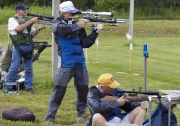
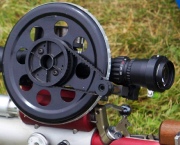
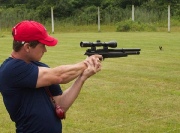
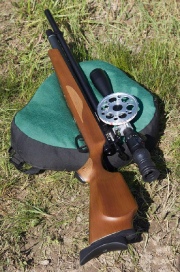
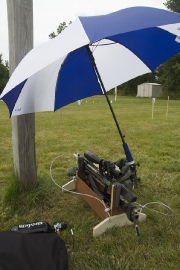




 5. Gas Block: You want a gas block that does not impose pointed stress on the barrel. Clamp-on types that grab all the way around the barrel are excellent. The blocks that are pinned on with tapered pins that wedge against the barrel or the slip on type of block with set screws that push up from underneath (or directly on the barrel) can deform the bore inside of the barrel and can wreck the accuracy of an otherwise great barrel.
5. Gas Block: You want a gas block that does not impose pointed stress on the barrel. Clamp-on types that grab all the way around the barrel are excellent. The blocks that are pinned on with tapered pins that wedge against the barrel or the slip on type of block with set screws that push up from underneath (or directly on the barrel) can deform the bore inside of the barrel and can wreck the accuracy of an otherwise great barrel.

 This article by Corey Swantz originally appeared in The Reloading Press, the Sinclair Int’l Blog.
This article by Corey Swantz originally appeared in The Reloading Press, the Sinclair Int’l Blog.
 The ScopeSaver Trunk rack holds four guns, is 23.5” deep, 23 7/8” wide, 13” high and is made of 10% fiberglass-filled polypropylene. It holds two large and two small oil/cleaning solution containers and multiple cleaning rods of different sizes. A special tapered-slot binding system allows several rods to be stored.
The ScopeSaver Trunk rack holds four guns, is 23.5” deep, 23 7/8” wide, 13” high and is made of 10% fiberglass-filled polypropylene. It holds two large and two small oil/cleaning solution containers and multiple cleaning rods of different sizes. A special tapered-slot binding system allows several rods to be stored.





